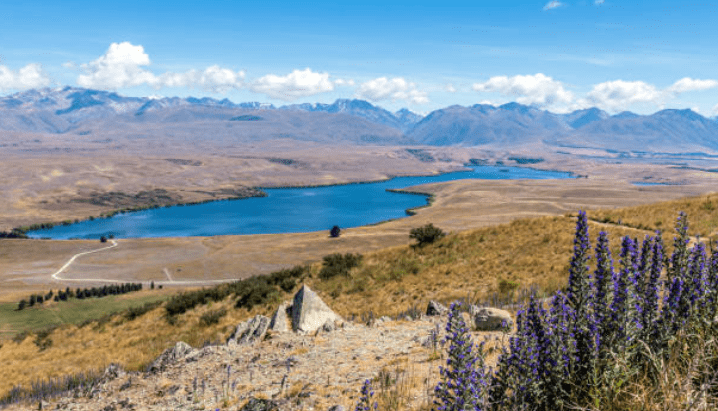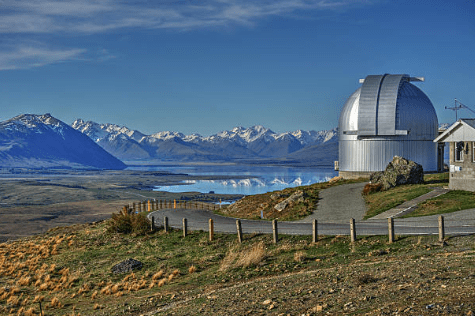For those who love stars and galaxies, Mount John Observatory in New Zealand is a must-visit destination. This isn’t just an ordinary observatory; it’s one of the coolest in the world! Let’s take a virtual tour and see what this place has to offer.
Best Stargazing at Mount John Observatory
Mount John Observatory is perched on a hill overlooking Lake Tekapo, just a few minutes’ drive from the town of Tekapo. What makes this observatory exceptional is the incredibly clear skies. Located in the Mackenzie Basin, sheltered from the rain shadows of the Alps, the area enjoys one of New Zealand’s driest climates. The hill’s elevation, about 1,000 meters, means there’s less atmosphere between the telescope and the stars. Operated by the University of Canterbury, the observatory offers both day and night tours. At 1,029 meters above sea level, Mount John provides a stunning 360-degree view, including the world’s largest accredited International Dark Sky Reserve.

Mount John Observatory: New Zealand’s Premier Astronomy Research Center
Mount John Observatory is New Zealand’s leading astronomical research facility, situated at 1,029 meters above sea level, putting you above the clouds. Opened in 1965, the observatory has made significant contributions to astronomy research. It houses several impressive telescopes, ranging from 0.4 meters to the massive 1.8-meter MOA telescope. The nearest town, Lake Tekapo, has a population of just over 500 people. About 20% of nights at Mount John Observatory offer excellent photometric conditions, while others are ideal for spectroscopy and direct photometry. The University of Canterbury’s Mount John Observatory is also home to HERCULES (High Efficiency and Resolution Canterbury University Large Echelle Spectrograph) and plays a key role in the MOA (Microlensing Observations in Astrophysics) collaboration between Japan and New Zealand.
International Dark Sky Reserve
In June 2012, 430,000 hectares around the observatory were designated as the Aoraki Mackenzie International Dark Sky Reserve by the International Dark-Sky Association, making it one of only four such reserves in the world at the time. The area has a Bortle scale rating of 2, indicating exceptionally dark skies ideal for stargazing.

Telescopes at Mount John Observatory
Mount John Observatory features five large telescopes used for astronomical research, as well as other amenities to enhance your visit. After a day of stargazing, you can grab a bite at the on-site café. For night owls, Dark Sky Project offers night tours where you can observe the stars in New Zealand’s famously dark skies. The observatory also has accommodations for visiting researchers, located within the 1.0-meter telescope building.
McLellan Telescope
The McLellan Telescope is a 1.0-meter Dall-Kirkham reflector telescope, in use since February 1986. It’s used for photometry with a CCD camera and fiber-optic spectroscopy connected to the HERCULES spectrograph. Named after Alister McLellan, former Head of the Department of Physics at the University of Canterbury, he played a key role in developing Mount John Observatory and was appointed its first director when the observatory opened in 1965.
Boller & Chivens Telescope
The Boller & Chivens Telescope is a 0.61-meter telescope used for photometry with an FLI CCD camera.
Optical Craftsmen Telescope
The Optical Craftsmen Telescope is another 0.61-meter telescope used exclusively for CCD photometry. It has been upgraded and enabled for robotic use as part of the AAVSO Robotic Telescope Network, being the first AAVSO southern hemisphere telescope.
Dark Sky Project Telescope
Finally, the Dark Sky Project telescope is a 0.4-meter Meade LX200 used exclusively for visual tourism operations. You can clearly see stars and planets through this telescope.

Fascinating Discoveries at Mount John Observatory
In June 2008, it was reported at the American Astronomical Society meeting that using their new MOA-II telescope, the observatory discovered the smallest known planet outside our Solar System at the time. The planet, MOA-2007-BLG-192Lb, is only 3.3 times larger than Earth and orbits a small star, MOA-2007-BLG-192L, located 3,000 light-years from Earth. The planet may have a thick atmosphere and liquid oceans on its surface.
So, that’s just a glimpse of Mount John Observatory, an incredible place to explore the beauty of the night sky. If you ever visit New Zealand, make sure to stop by here. You’ll be amazed by the stunning beauty of the universe above us.
Lake Tekapo Dark Sky Project: An Unforgettable Stargazing Experience
Lake Tekapo, located within the Aoraki Mackenzie International Dark Sky Reserve, offers one of the world’s best stargazing experiences. The Lake Tekapo Dark Sky Project is a leading initiative focused on preserving the pristine night sky and spreading knowledge about the cosmos. This article delves into the project, the importance of dark sky preservation, and the unique experiences it offers visitors.
What is the Dark Sky Project?
Formerly known as Earth & Sky, the Lake Tekapo Dark Sky Project is a recognized leader in astro-tourism. The project offers a variety of experiences that are not only entertaining but also educational. One of the main attractions is the stargazing tour from the summit of Mount John, where visitors can enjoy spectacular night sky views.
A Leader in Astro-Tourism
The project offers astronomy tours led by professional guides who provide scientific insights and stories about how the night sky has influenced Māori culture. These experiences are designed to inspire wonder and interest in preserving the night sky.
Cultural Significance
In Māori tradition, the night sky holds deep cultural significance. The Dark Sky Project emphasizes the importance of this culture and aims to raise awareness of how dark sky preservation is linked to preserving cultural and ecological heritage.
Experiences Offered
The Lake Tekapo Dark Sky Project offers a range of experiences that allow visitors to enjoy the wonders of the night sky uniquely and profoundly. Here are some of the main experiences offered:
Stargazing Tours
These tours are guided by astronomy experts who provide in-depth explanations of the celestial objects visible. Using advanced telescopes, visitors can see stars, planets, and galaxies that are invisible to the naked eye.
Facilities
The project’s base building, located on the shores of Lake Tekapo, houses the Dark Sky Diner, where visitors can enjoy a meal while taking in stunning night sky views. This facility also serves as a hub for various astronomy activities, including workshops and multimedia presentations.
Multimedia Experience
One unique feature of the Dark Sky Project is the multimedia astronomy experience that combines Māori stories about the stars with modern scientific knowledge. This offers a holistic perspective on the cosmos and our place within it.
The Importance of Dark Sky Preservation
A dark sky is not just about visual beauty; it’s also vital for ecology and culture. Preserving the night sky is an essential part of global efforts to reduce light pollution and protect the natural environment. Here are some reasons why dark sky preservation is so important:
Cultural Heritage
For the Māori community and many other cultures, the night sky is integral to their heritage. Mythology, navigation, and traditional calendars are all tied to star observation. Preserving the night sky helps preserve these cultures.
Ecology
A dark sky supports nocturnal wildlife. Many animals rely on natural day-night cycles for feeding, breeding, and migration. Light pollution can disrupt these cycles and harm ecosystems.
Education and Awareness
Through projects like the Dark Sky Project, the public can learn about the importance of preserving the night sky. This helps raise awareness of how our actions affect the environment and encourages us to take steps to reduce light pollution.
Conservation Efforts in New Zealand
New Zealand has taken significant steps toward becoming a “dark sky nation.” Māori communities, along with environmental organizations and the government, are working together to reduce light pollution and preserve the night sky. These initiatives include implementing more eco-friendly lighting and educating the public on the importance of dark skies.
Role of the Māori Community
The Māori community plays a crucial role in these conservation efforts. They bring a rich cultural perspective on the importance of the night sky. Through collaboration with projects like the Dark Sky Project, they can share their knowledge with visitors and raise global awareness about cultural and environmental preservation.
Enhancing Facilities
The Lake Tekapo Dark Sky Project is an example of how modern facilities can be designed to support dark sky preservation. By using advanced and eco-friendly lighting technology, this facility minimizes light pollution and provides a deep experience for visitors without harming the natural environment.
